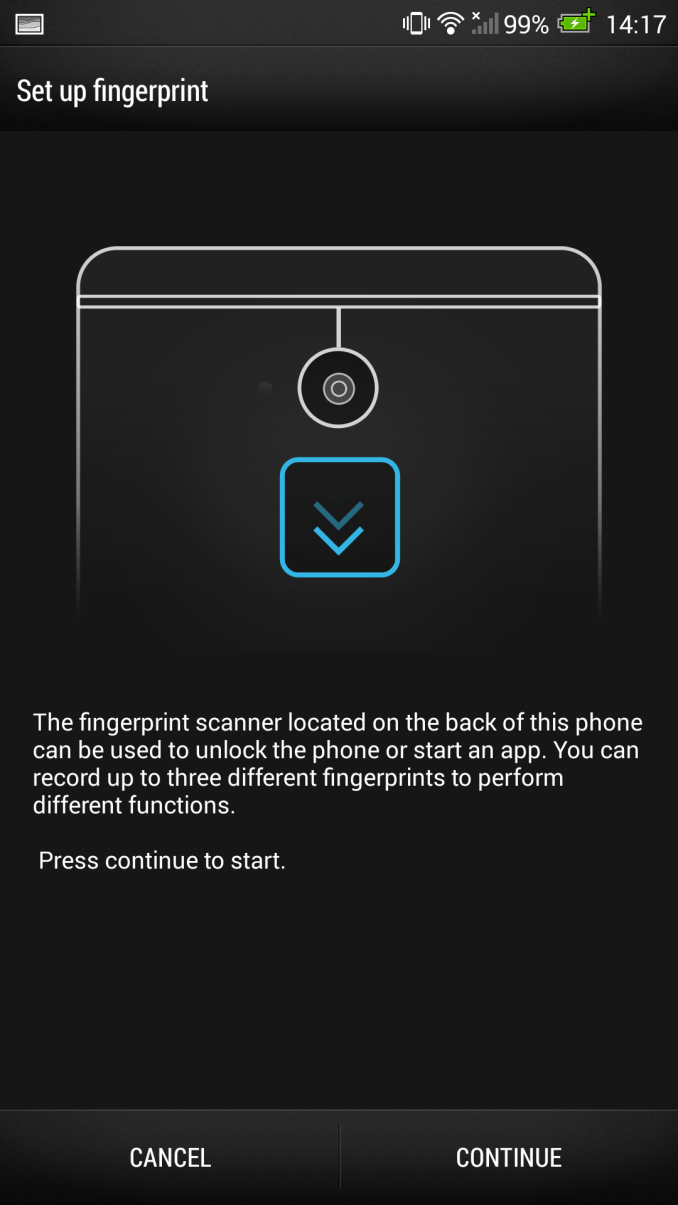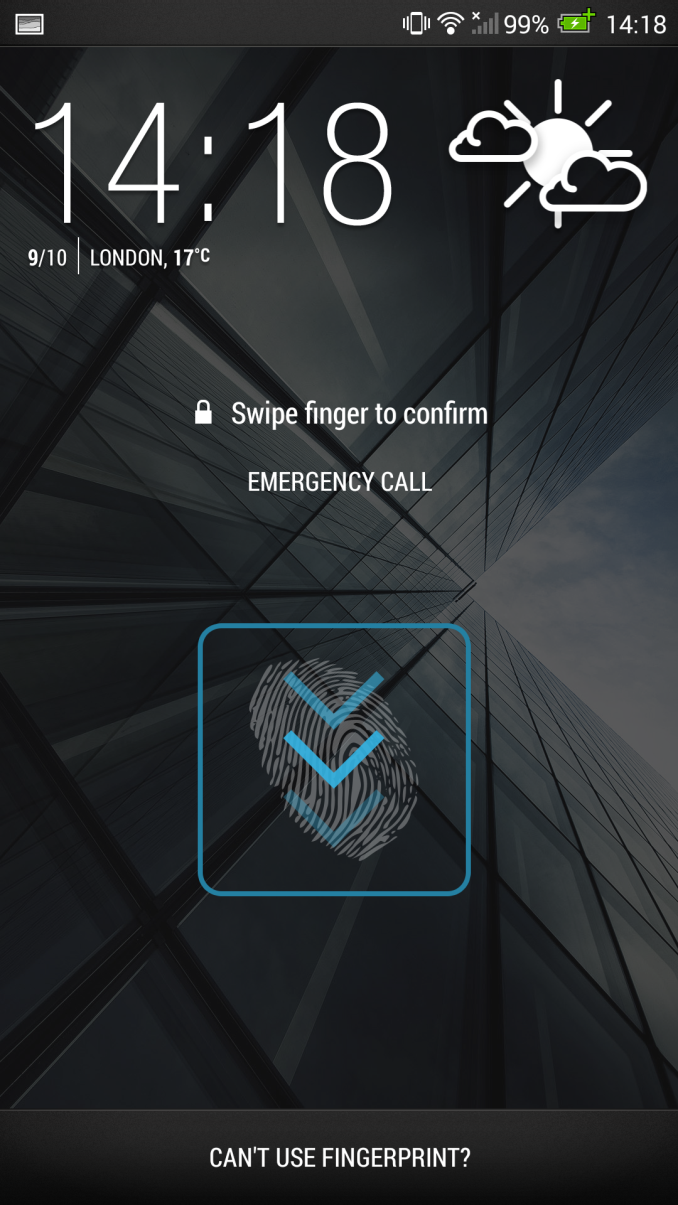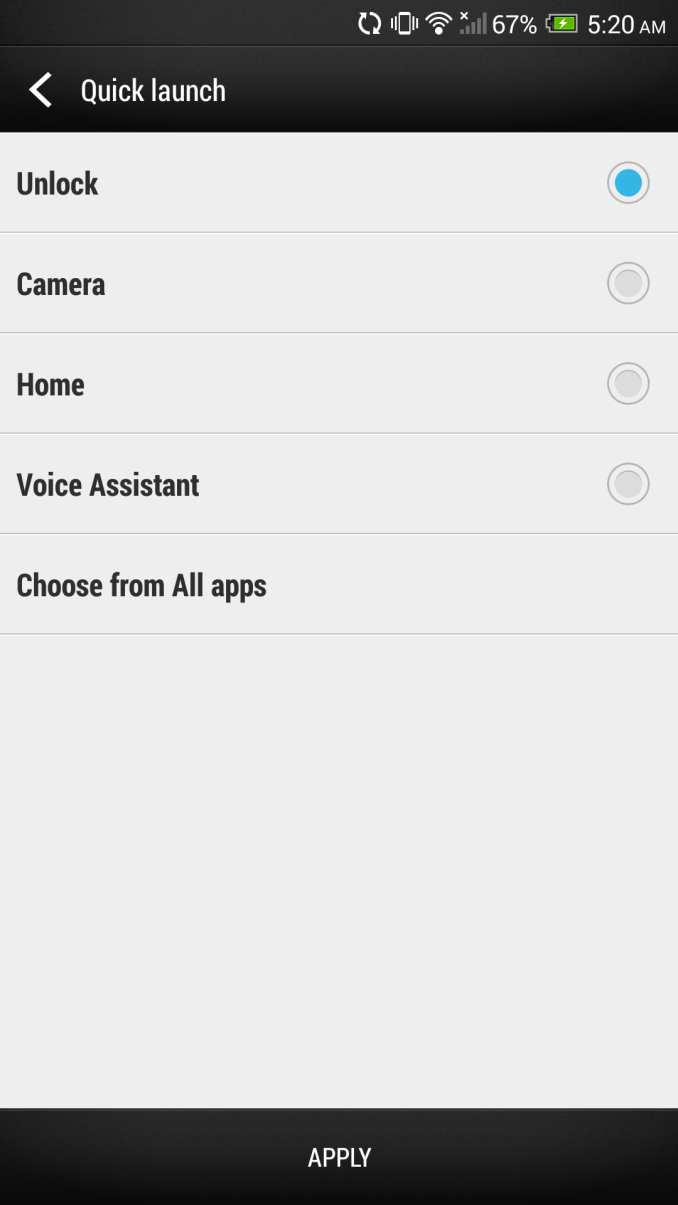HTC One max Review - It's Huge
by Brian Klug on October 28, 2013 10:00 AM EST- Posted in
- Smartphones
- HTC
- Mobile
- One
- Snapdragon 600
- Android 4.3
- One max
The One max joins a small but growing list of phones that include a fingerprint scanner for unlocking the device. I’ll leave the discussion about whether fingerprints are fundamentally usernames or passwords for another day, but fingerprint scanners seem to be in vogue right now for mobile phones. You could make the case that the perceived increase in security that comes with fingerprint scanners is both an enterprise or consumer play, again I’ll leave that philosophical discussion for another day. I remember the Motorola Atrix and its fingerprint scanner being a big deal a while ago, since then we’ve had the iPhone 5s dramatically reintroduce the fingerprint scanner and now the One max follow suit.
The One max fingerprint sensor is a swipe type, meaning there’s some kind of strip sensor inside that you swipe your finger across. Sliding your finger over this strip allows the module to scan a 2D region and extract features that are then used to identify a fingerprint. The One max hides this scanner inside a black square that’s slightly recessed on the back of the device, just beneath the camera. I’m reminded somewhat of the LG G2 and its rear-mounted power and volume buttons which also sit just beneath the rear-facing camera. Perhaps that’s a missed opportunity for LG, which could have also gone with a swipe type sensor in its power button. On the One max anyhow there’s no button, just the sensor. Although the fingerprint sensor is recessed slightly, it’s somewhat difficult to locate with just one’s index finger, something that results in inadvertent smudging of the rear-facing camera cover glass, something that didn’t happen as much with the G2 because there’s a larger lip and easily locatable bump.
The placement of the fingerprint sensor makes sense given that of the power button. As stated earlier for right handed users this means your index finger sits naturally near the sensor if your thumb is on the power button. Since the fingerprint button still requires activation to unlock the One max, you still need to press power to turn it on before you can swipe your finger and finally unlock it. I find myself wishing the fingerprint sensor was itself a button, something like the iPhone 5s, so unlocking could be as simple as pressing and swiping with the same finger. On the iPhone 5s the best activation pattern is pressing the home button and leaving the finger in contact with the button.
Setup requires you to set a passcode, after which a few training swipes trains the sensor for the finger you’ve chosen. Although the animation that plays shows the finger aligned along the long axis of the phone, for greater accuracy I trained the One max with my finger at the angle it would naturally be given my thumb on the power button. The only requirement given the swipe sensor is that the slide motion is straight down and not skewed.
The One max fingerprint sensor allows for up to 3 fingers to be paired, each able to either unlock or have the option of both unlocking and launching an application. I like the idea of fingerprints as shortcuts, something the iPhone 5s implementation lacks, but three fingers seems like a curiously low number given the ten digits humans have to work with. On the other hand, the placement of the button really limits you to middle and index fingers being viable options. In terms of functionality, although Apple doesn’t yet use fingerprints as shortcuts, Apple does use the fingerprint scanner to authenticate iTunes, iBooks, and App Store purchases, something HTC can’t quite do with the One max for Google Play purchases, at least until Google makes an API for it.
I initially trained the fingerprint sensor with my index finger being swiped straight down, and had some issues with unlocks requiring multiple swipes. Doing finger enrollment and training at an angle closer to how I actually swipe it naturally (at an angle) made the accuracy better, but the reality is that unlocking the One max still requires multiple tries more often than not. There isn’t much processing latency after a scan, but I had hoped the One max sensor would be tap and hold rather than swipe given its shape. I’m not clear what suppliers are involved for the sensor, but I’m told the One max also securely stores just the extracted features and not the fingerprint images (which is a no brainer). I haven’t delved much into the infrastructure used to secure the fingerprint features yet either. I’m also not sure whether the One max learns additional parts of the finger which wasn’t part of initial training the same way Apple’s does.
Although I don’t think anyone has totally nailed the fingerprint sensor yet on a device, the One max implementation definitely is further from perfection than Apple’s. Although it does work reasonably well, it still isn’t the transparent kind of convenience that I feel will compel users who ordinarily wouldn’t have to used a passcode to go and use the fingerprint scanner. I’ve continued using the fingerprint scanner on the One max, however.
















197 Comments
View All Comments
PC Perv - Tuesday, October 29, 2013 - link
Hah. At least you are being honest here. Of course you won't review anything unless you get it for free. (and then some)Black Obsidian - Tuesday, October 29, 2013 - link
This isn't the glory days of the dot-com boom. Few (if any) sites have the kind of budget that allows them to go out and buy whatever random devices their readership expects them to review.I'm sure that Brian would consider reviewing your favored device if you wanted to send him one, though.
JMFL - Monday, October 28, 2013 - link
Mostly decent review, except in my opinion Brian's equivocation regarding the finger print sensor in comparison to Apple's. To be fair Brian stated that the One Max sensor is "further from perfection than Apple's", however from reading the rest of the text, one could come to the conclusion that in the grand scheme of things the HTC's and Apple's sensors are more similar than not.I would hazard to guess that in 6 months time, most Iphone 5S users will be using the fingerprint scanner. I don't think the same will be said for the HTC Once Max sensor.
ddriver - Monday, October 28, 2013 - link
It doesn't really matter what apple does, everything apple does is amazing because it is done by apple by default. IIRC the review at engadget: "note 3 - cheap plastic - product sucks" and then "iphone 5c - amazing plastic - product rocks".Things have come to a point you cannot really expect honesty from review sites, no matter how "trusted" they themselves claim to be.
Fingerprint readers are a government sponsored scam to build fingerprint databases for god knows what ill purposes, glad I got the note 3 as it looks like the note 4 will have a fingerprint sensor as well. Fingerprints are considered lower security level than even passwords, a password is in the brain, a fingerprint can be extracted from everything you touch.
blacks329 - Monday, October 28, 2013 - link
People perceive (whether correctly or incorrectly) that rigidity in their phone means it is a more durable device and that the rigidity give a better in hand feel.The iPhone 5C feels really solid, like the Lumia's, there's no flex. So I can understand the merits of claiming "cheap" plastic.
steven75 - Thursday, October 31, 2013 - link
It doesn't matter how many times you tell this to ddriver. He has made up his mind that material usage is a binary thing.Spunjji - Monday, October 28, 2013 - link
"For the incredibly small percentage of users that clamors for an SD card every single smartphone launch, it’s at least one point which won’t be belabored so tiresomely this time."Gee, thanks for making me feel like a dick for not wanting to pony up £80 for £10 worth of low performing NAND.
We get it, you don't think these things are worthwhile. That's your opinion and you're entitled to it. That doesn't justify a paragraph of text dedicated to mocking and marginalising a chunk of your readership. It devalues your opinion.
themossie - Monday, October 28, 2013 - link
Agreed. Brian, you write superb reviews but that has no place here.kmmatney - Monday, October 28, 2013 - link
I agree. I've been an iPhone user for 4 years, but switched to the Optimus G Pro (also a huge 5.5" phone) and one of the draws was expanding the storage. It's a big enough phone to be able to read work instructions quite easily, so I have a lot of PDFs and documents on it, as well as 20GB of music. More storage never hurts. I didn't have too much trouble filling up my 32GB iPhone. I can live without it, but if choosing between 2 phones, and one has it and noe doesn't, you might as well buy the phone with more options.Brian Klug - Monday, October 28, 2013 - link
See my above comment, the reality is that it is a very tiny part of the market, and an exceptionally loud one.-Brian